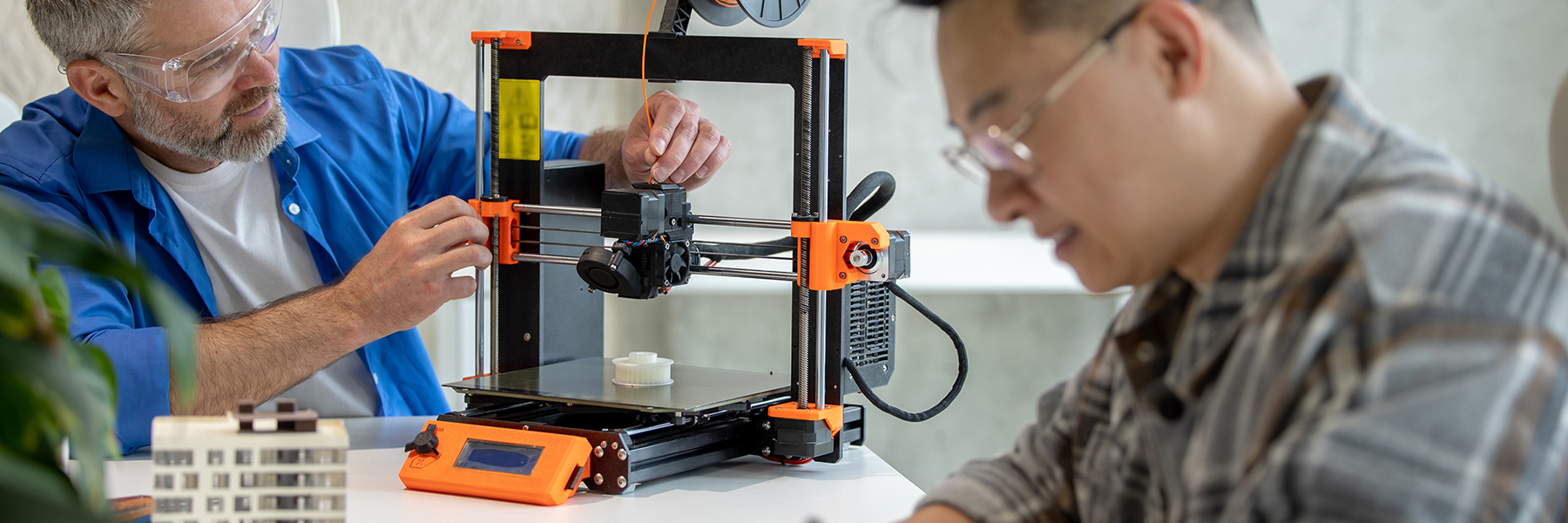Three-dimensional (3D) printing has transformed how people design, create, and learn. What once seemed like advanced manufacturing technology is now a practical tool for offices, classrooms, and creative workspaces everywhere.
Whether you’re building prototypes for a client, teaching STEM concepts, or designing custom equipment, understanding how 3D printers work opens new opportunities for innovation and problem-solving.
At ISBS, we help organizations explore how 3D printing fits into their workflows—from equipment selection to system integration—so they can bring big ideas to life efficiently and affordably.
What Is 3D Printing?
3D printing, also known as additive manufacturing, is the process of creating physical objects layer by layer from a digital model. Instead of cutting away from a block of material (as in traditional manufacturing), 3D printers build items by depositing material precisely where it’s needed.
This approach allows for complex designs, custom parts, and low-volume production—all without requiring expensive molds or specialized tooling.
For offices and classrooms, this means faster creation of models, visual aids, and prototypes that help turn ideas into tangible results.
The Technology Behind 3D Printers
Modern 3D printers combine software, hardware, and precision engineering to produce high-quality results. The process starts with a 3D model created using design software (CAD). Once finalized, the model is sent to the printer, which follows digital instructions to create the object layer by layer.
Materials used in 3D printing
3D printers use a variety of materials depending on their purpose:
- PLA (Polylactic Acid): A biodegradable, easy-to-use filament ideal for classrooms and general use.
- ABS (Acrylonitrile Butadiene Styrene): A durable plastic used for prototypes and mechanical parts.
- Resins and composites: Used in higher-end printers for smooth finishes, flexibility, or metal-like strength.
Advancements in 3D printing now include materials designed for specialized industries—from heat-resistant plastics to biocompatible resins—expanding possibilities across business and education.
Common Uses in Offices and Classrooms
3D printing is no longer limited to engineering labs or design studios. It’s become a practical resource for professionals, educators, and students.
In the office: 3D printers are valuable for teams looking to prototype products, create replacement parts, or develop mock-ups for presentations. They help visualize concepts quickly and affordably, reducing reliance on outsourcing.
In the classroom: 3D printing brings lessons to life. From science experiments to art projects, students can design and create real objects that enhance understanding and engagement.
Examples of classroom projects
- Printing geometric shapes to explain volume and area.
- Building models of molecules, organs, or ecosystems.
- Creating historical artifacts for hands-on learning.
- Designing prototypes for robotics and engineering challenges.
Office prototyping applications
- Creating proof-of-concept models for client presentations.
- Producing spare parts or customized office components.
- Testing designs before committing to large-scale manufacturing.
In both settings, 3D printing helps bridge the gap between imagination and application, encouraging collaboration and creativity.
Benefits of 3D Printing for Learning and Work
The benefits of 3D printing extend far beyond convenience. When used strategically, it enhances productivity, creativity, and innovation across industries.
- Accelerates innovation: Teams can test and refine ideas quickly without costly delays.
- Improves learning outcomes: Students engage more deeply when they can see and touch what they’re learning.
- Reduces waste: Additive manufacturing uses only the material needed, lowering environmental impact.
- Encourages collaboration: Teams and classrooms work together to problem-solve through design and creation.
- Supports customization: 3D printing allows for tailored solutions—from one-of-a-kind prototypes to teaching tools built for specific lessons.
By bringing design and production capabilities in-house, organizations save time and gain creative control over their projects.
Choosing the Right 3D Printer
With so many models available, selecting the right 3D printer depends on your goals, volume needs, and experience level.
- For classrooms: Look for reliable printers with safety features, easy-to-use software, and durable filaments like PLA.
- For offices: Choose printers that balance speed, precision, and material flexibility to support various professional applications.
- For shared environments: Network-ready printers that integrate with your office systems provide scalability and convenience.
Before investing, consider how a printer fits into your existing workflow and whether you’ll need additional software or training to maximize its value.
ISBS helps clients identify the ideal 3D printing solutions for their environment, ensuring seamless integration with other office technologies and long-term support.
Transform Your Workflow with 3D Printing
Whether you’re a teacher looking to make lessons more interactive or a business leader exploring rapid prototyping, 3D printing offers a hands-on way to enhance creativity and efficiency.
The technology is no longer reserved for specialists—it’s accessible, affordable, and adaptable to virtually any environment.
Interested in learning more about 3D printing solutions for your office or classroom? Contact ISBS to explore equipment options, training, and setup services that help bring your ideas to life.




